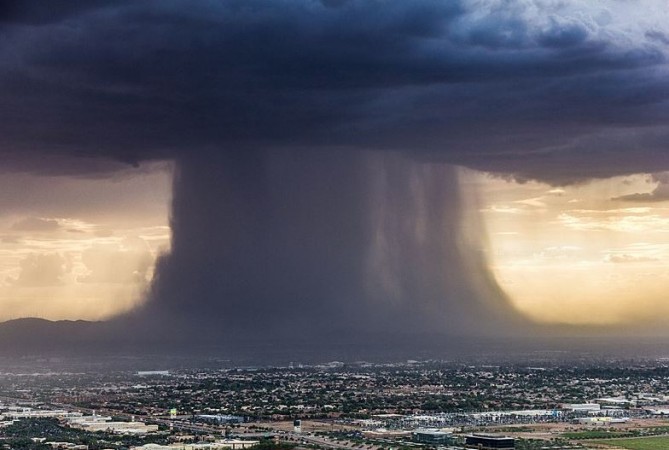
Cloud bursts are extreme weather events characterized by intense rainfall over a relatively short period. These powerful downpours can unleash a deluge of water, overwhelming drainage systems and causing flash floods and landslides. Cloud bursts are phenomena that capture the imagination and evoke both awe and fear due to their sudden and destructive nature. In this article, we will delve into the meaning of cloud bursts, explore why they occur, explore their effects, and examine the regions most susceptible to these dramatic weather events.
Meaning of Cloud Bursts:
Cloud bursts refer to concentrated and torrential rainfalls that occur within a short duration, often lasting from a few minutes to a couple of hours. During a cloud burst, rainfall rates can reach exceptionally high levels, exceeding the capacity of the local infrastructure to cope with such an influx of water. The result is a rapid accumulation of water on the ground, leading to flooding and other associated hazards.
Causes of Cloud Bursts:
Cloud bursts are primarily caused by a combination of atmospheric and meteorological factors. One of the main triggers is the presence of a convective weather system, where warm, moist air rises rapidly and condenses into clouds. When the atmospheric conditions are favorable, these clouds can rapidly grow and develop into towering thunderclouds, which are associated with thunderstorms. These clouds act as a catalyst for intense rainfall due to their vertical development and the presence of abundant moisture.
Factors such as atmospheric instability, temperature gradients, and wind shear contribute to the formation and intensification of cloud bursts. Additionally, geographical features like mountains or hilly terrains can enhance the uplift of air, leading to more significant precipitation. Climate change and global warming may also influence the frequency and intensity of cloud bursts, although further research is necessary to establish conclusive links.
4 Effects of Cloud Burst -
Cloud bursts, with their intense and concentrated rainfall, can have significant effects on the environment and human settlements. Here are four effects of cloud bursts:
1. Flash Flooding -
One of the most immediate and impactful effects of cloud bursts is flash flooding. The rapid and excessive rainfall overwhelms the capacity of local drainage systems and natural water channels, leading to the sudden and massive accumulation of water. Flash floods can submerge roads, engulf homes and buildings, and pose a serious threat to human life and safety. The force of the rushing water can also cause erosion and damage to infrastructure, including bridges and roads.
2. Landslides and Mudslides -
Cloud bursts can trigger landslides and mudslides, particularly in hilly or mountainous regions. The heavy rainfall saturates the soil, reducing its stability and increasing the likelihood of slope failures. Landslides can result in the displacement of soil, rocks, and debris downhill, posing a significant risk to communities residing in vulnerable areas. These events can destroy homes, disrupt transportation routes, and even lead to casualties.
3. Crop Damage and Agricultural Losses -
Cloud bursts can have a destructive impact on agriculture. The intense rainfall can drown crops, wash away topsoil, and damage agricultural infrastructure. In addition to immediate losses, such as destroyed crops, farmers may also experience long-term effects, including soil erosion, reduced fertility, and increased susceptibility to pests and diseases. These consequences can have serious implications for food security and livelihoods in affected areas.
4. Water Contamination and Disease Outbreaks -
Excessive rainfall from cloud bursts can result in the contamination of water sources. Floodwaters can carry pollutants, debris, and harmful microorganisms, leading to waterborne diseases. The overflow of sewage systems and the mixing of wastewater with clean water sources pose a significant health risk to the affected population. Diseases such as cholera, typhoid, and hepatitis can spread rapidly in the aftermath of a cloud burst, making the impact of the disaster worse.
Regions Prone to Cloud Bursts:
Cloud bursts can occur in various parts of the world, but certain regions are particularly susceptible due to their climatic and geographical characteristics. Mountainous areas, such as the Himalayas in South Asia or the Andes in South America, experience frequent cloud bursts due to the orographic lifting of air masses and the presence of monsoon systems. Coastal regions with warm sea surfaces, like the Indian subcontinent during the summer monsoon season, also witness these intense rainfall events.
Furthermore, locations with a history of convective thunderstorms, such as the central United States, the Sahel region in Africa, or the Amazon rainforest, are prone to cloud bursts. These areas often have the ideal combination of atmospheric conditions conducive to the development of powerful storms and subsequent torrential rainfalls.
Cloud bursts are formidable natural phenomena that unleash intense rainfall within a short period. Understanding the causes and vulnerable regions of cloud bursts is crucial for disaster preparedness and mitigation efforts. By comprehending the mechanisms behind these extreme weather events, scientists, policymakers, and communities can work together to develop strategies to reduce the impact of cloud bursts and protect lives and infrastructure from their devastating consequences.
Also read: The Impact of Climate Change on Wildlife: Protecting Earth's Biodiversity
Climate Crisis Escalates: Global Warming Exceeds 1.5°C Limit as Record Heat Sweeps the Planet